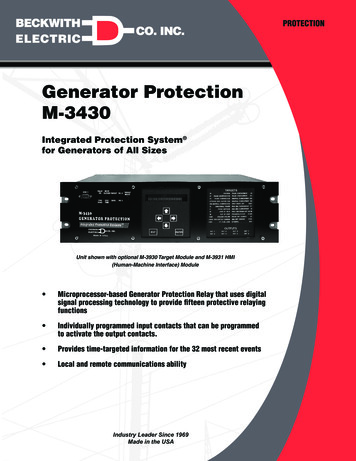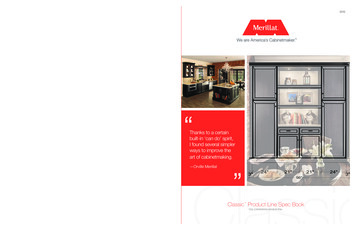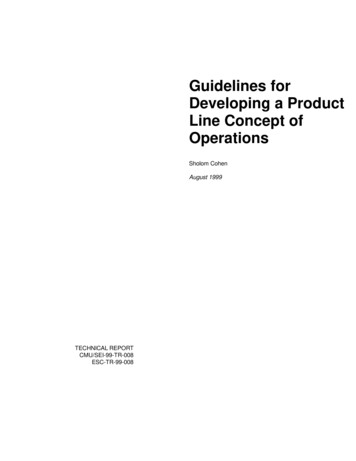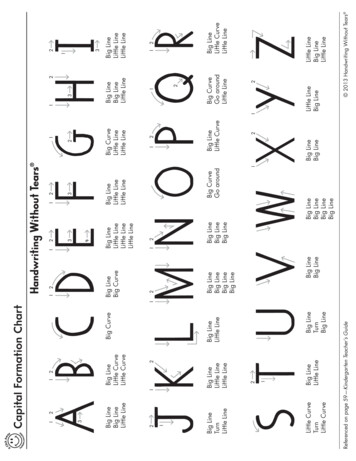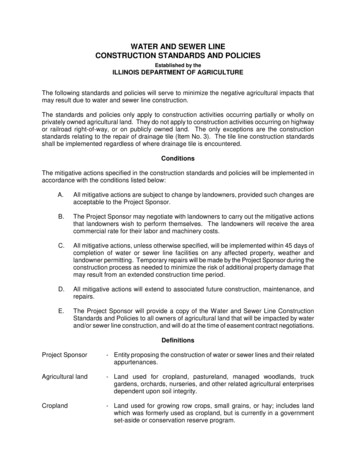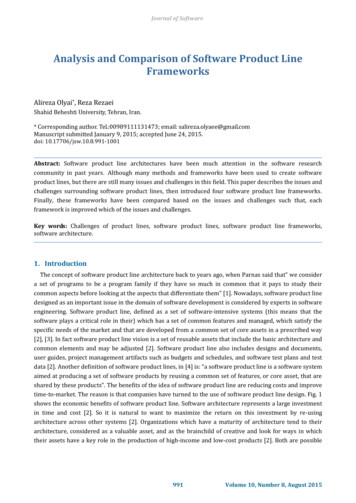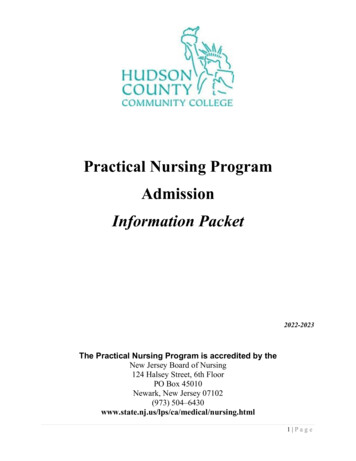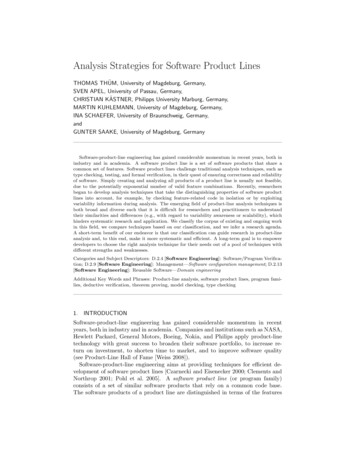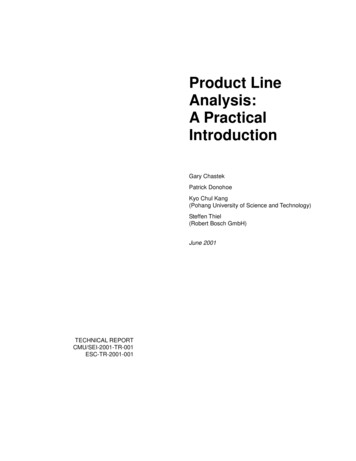
Transcription
Product LineAnalysis:A PracticalIntroductionGary ChastekPatrick DonohoeKyo Chul Kang(Pohang University of Science and Technology)Steffen Thiel(Robert Bosch GmbH)June 2001TECHNICAL REPORTCMU/SEI-2001-TR-001ESC-TR-2001-001
Pittsburgh, PA 15213-3890Product LineAnalysis:A 1-001Gary ChastekPatrick DonohoeKyo Chul Kang (Pohang University of Science and Technology)Steffen Thiel (Robert Bosch GmbH)June 2001Product Line Systems ProgramUnlimited distribution subject to the copyright.
This report was prepared for theSEI Joint Program OfficeHQ ESC/DIB5 Eglin StreetHanscom AFB, MA 01731-2116The ideas and findings in this report should not be construed as an official DoD position. It is published in the interest ofscientific and technical information exchange.FOR THE COMMANDERNorton L. Compton, Lt Col., USAFSEI Joint Program OfficeThis work is sponsored by the U.S. Department of Defense. The Software Engineering Institute is afederally funded research and development center sponsored by the U.S. Department of Defense.Copyright 2001 by Carnegie Mellon University.NO WARRANTYTHIS CARNEGIE MELLON UNIVERSITY AND SOFTWARE ENGINEERING INSTITUTE MATERIAL ISFURNISHED ON AN "AS-IS" BASIS. CARNEGIE MELLON UNIVERSITY MAKES NO WARRANTIES OF ANYKIND, EITHER EXPRESSED OR IMPLIED, AS TO ANY MATTER INCLUDING, BUT NOT LIMITED TO,WARRANTY OF FITNESS FOR PURPOSE OR MERCHANTABILITY, EXCLUSIVITY, OR RESULTS OBTAINEDFROM USE OF THE MATERIAL. CARNEGIE MELLON UNIVERSITY DOES NOT MAKE ANY WARRANTY OFANY KIND WITH RESPECT TO FREEDOM FROM PATENT, TRADEMARK, OR COPYRIGHT INFRINGEMENT.Use of any trademarks in this report is not intended in any way to infringe on the rights of the trademark holder.Internal use. Permission to reproduce this document and to prepare derivative works from this document for internal use isgranted, provided the copyright and "No Warranty" statements are included with all reproductions and derivative works.External use. Requests for permission to reproduce this document or prepare derivative works of this document for externaland commercial use should be addressed to the SEI Licensing Agent.This work was created in the performance of Federal Government Contract Number F19628-00-C-0003 with CarnegieMellon University for the operation of the Software Engineering Institute, a federally funded research and developmentcenter. The Government of the United States has a royalty-free government-purpose license to use, duplicate, or disclose thework, in whole or in part and in any manner, and to have or permit others to do so, for government purposes pursuant to thecopyright license under the clause at 52.227-7013.For information about purchasing paper copies of SEI reports, please visit the publications portion of our Web ml).Last printed 9/27/01 7:47 AM / version 2.1 / bw4le
Table of n1.1 The Context of Product Line Analysis1.2 About This Report1232Product Line Requirements2.1 Sources of Product Line Requirements2.1.1 Product Line Stakeholders2.1.2 Product Line Practice Areas2.2 Users of Product Line Requirements2.3 From Requirements to Architecture2.4 Introduction to the Example: HomeIntegration System (HIS)2.4.1 Business Context2.4.2 The Econo-HIS product2.4.3 The Lux-HIS Product2.5 Summary566810103The Requirements Model3.1 The Use-Case Model3.2 The Object Model3.3 The Feature Model3.4 The Dictionary3.5 Work Product Relationships3.6 Summary151517192121244Requirements Modeling4.1 Recursive Refinement25251111121213i
4.24.34.4Analysis4.2.1 Commonality and VariabilityAnalysis4.2.2 Consistency Analysis4.2.3 Feature Interaction Analysis4.2.4 Model Quality Analysis4.2.5 Requirements Priority AnalysisVerificationSummary283030313132335Modeling Strategies5.1 A Feature-Driven Strategy5.1.1 Strategy Context5.1.2 Feature Modeling5.1.3 Use-Case Modeling5.1.4 Object Modeling5.2 A Use-Case-Driven Strategy5.2.1 Strategy Context5.2.2 Use-Case Modeling5.2.3 Feature Modeling5.2.4 Object Modeling5.3 Summary3536363738383939404041416Conclusions and Future Work6.1 Robustness6.2 Extensions434344ReferencesAppendix A:Appendix B:ii2847Example StakeholderChecklist51Work Product Interactions53CMU/SEI-2001-TR-001
List of FiguresFigure 1: Product Line Requirements: Coverage 5Figure 2: Stakeholder Views7Figure 3: Practice Areas: Initial RequirementsInformation Sources9Figure 4: Stakeholder Hierarchy16Figure 5: Requirements Objects and InformationExchanges19Figure 6: HIS Feature Model – Upper Levels20Figure 7: Safety Features of HIS20Figure 8: Relationships Among Use Cases,Objects, and Features22Figure 9: Work Product Relationships22Figure 10: Model Relationships Under the FeatureDriven Strategy37Figure 11: Model Relationships Under the UseCase-Driven StrategyCMU/SEI-2001-TR-00140iii
ivCMU/SEI-2001-TR-001
List of TablesTable 1:Table 2:CMU/SEI-2001-TR-001Recursive Refinement of theRequirements Model26Example Checklist of Product LineStakeholders51v
viCMU/SEI-2001-TR-001
AbstractProduct line analysis applies established modeling techniques to engineer the requirementsfor a product line of software-intensive systems. This report provides practitioners with apractical introduction to product line requirements modeling. It describes product line analysis in the context of product line development. The report also shows how a requirementsmodel is built from work products that are based on object modeling, use-case modeling, andfeature-modeling techniques. A running example, based on home automation systems, illustrates concepts and terminology. Two different strategies for creating the requirements modelare also presented.The product line analysis work is evolving. This report describes its current status andplanned development.CMU/SEI-2001-TR-001vii
viiiCMU/SEI-2001-TR-001
1 IntroductionProduct line analysis is requirements engineering for a product line of software-intensive systems. It encompasses the elicitation, analysis, specification, and verification1 of the requirements for a product line. It is the requirements analyst’s perspective of the role of requirements engineering in a product line development.Requirements are statements of what a system must do, how it must behave, the properties itmust exhibit, the qualities it must possess, and the constraints that the system and its development must satisfy. The Institute of Electrical and Electronic Engineers (IEEE) defines arequirement as1.a condition or capability needed by a user to solve a problem or achieve an objective2.a condition or capability that must be met or possessed by a system or system component to satisfy a contract, standard, specification, or other formally imposed document3.a documented representation of a condition or capability as in (1) or (2) [IEEE 90]Product line analysis specifies requirements for a product line in a model rather than a natural-language document [Böckle 00, Jacobson 97]. Its primary goal is identifying and analyzing opportunities for large-grained reuse within the requirements. To achieve this, it creates arequirements model that identifies common requirements across the product line and the acceptable variations of those requirements. The model has two important characteristics:1.It specifies the functionality and quality attributes (such as performance or modifiability)of the products in the product line.2.Its structure reflects decisions about common and variant capabilities and behaviorsacross the product line.The requirements model also serves as a fundamental communications mechanism betweendevelopers and other stakeholders of a product1For brevity, in this report the term verification also includes validation, except in cases where thespecific activities of one or the other are discussed.CMU/SEI-2001-TR-0011
1.1 The Context of Product Line AnalysisProduct line analysis is part of product line development.2 The decision to develop and manage a product line begins with identifying a business opportunity that, potentially, can be realized by exploiting strategic reuse; that is, creating sets of related products from commonparts. Product line development spans the path from the initial recognition of such a businessopportunity to the creation of the actual products. The products result from business and engineering decisions that determine what products to offer, how they should be built, and howthey should evolve over the life of the product line. These decisions center on an organization’s ability to develop assets that can be reused in multiple products. Furthermore, decisionsabout the evolution of a single product are made within the broader context of the evolutionof the product line.Clements and Northrop define a software product line as follows [Clements 01]:A software product line is a set of software-intensive systems sharing a common,managed set of features that satisfy the specific needs of a particular market ormission and that are developed from a common set of core assets in a prescribedway.The requirements for a product line cover not only products and their features, but also information to support business and technical decisions.This report focuses on product line analysis as it applies to asset development, in particularthe assets created by the product line architect (for reasons discussed in Section 2). Productline analysis ensures that the asset requirements are specified in a form that facilitates reasoning about the products in the product line, and the reusable assets that support them. The emphasis is on understanding what needs to be done to make the product line a reality from adevelopment (as opposed to a managerial or organizational) point of view. This understanding must be represented in a way that can be communicated to the design team before designor implementation decisions are made.To be effective, product line analysis must capture current products being built by the organization that are candidates for inclusion in theproduct line future envisioned products the relevant requirements of the various product line stakeholders and the associated rationales and tradeoffs2The term development is an abstraction that covers the multiple ways in which assets or productsactually come to fruition. Development may involve building, acquiring, purchasing, retrofittingearlier work, or any combination of these options.2CMU/SEI-2001-TR-001
The modeling activities elicit requirements information from stakeholders, and specify, analyze, and verify the requirements across the product line. The requirements model is structured to meet the needs of the stakeholders and to provide a framework for commonality andvariability analysis.1.2 About This ReportThis report introduces product line requirements as a set of essential work products. It describes these work products and their functions, strengths, and weaknesses. It also shows howthey relate to each other, and how they express decisions about commonality and variability.A running example presents concepts and terminology.This report does not prescribe a process for product line analysis, nor is it a product lineanalysis process model. It does describe two modeling strategies: a feature-based strategy anda use-case-based strategy. While the modeling does not necessarily represent all modelingtechniques required by any application domain (e.g., finite state modeling for real-time embedded systems), it is the authors’ experience that the requirements model contains the information vital for product line asset development. Particular application domains may supplement the requirements model with additional representations where useful.The content of this report evolved from a collaborative effort between the Software Engineering Institute (SEI) and an industrial partner, the Robert Bosch Corporation, to define the requirements and the architecture of a new product line [Thiel 00]. The initial requirementsmodel, based on domain analysis techniques, proved awkward because the product linecrossed multiple domains. The solution was an approach that utilized techniques from domain analysis and object technology but that focused on the product line rather than domains.Feature-oriented domain analysis [Kang 90, Lee 00] and use-case modeling [Jacobson 97]were employed for this purpose, and the approach evolved into product line analysis. Theapproach has also been influenced by Martin Griss’s work on adding features to the Reusedriven Software Engineering Business [Griss 98], and work of the SEI on the ArchitectureTradeoff Analysis MethodSM (ATAMSM) [Kazman 00] and the Attribute Driven Design(ADD) method (formerly known as the Architecture Based Design method) [Bachmann 00].This document is intended for product line requirements engineers, product line designerswho need usable, useful representations of requirements, and technology developers interested in creating tools to support them. Technical managers may be interested in Sections 1and 2. Readers should be familiar with the Framework for Software Product Line Practice[SEI 00], as well as Software Product Lines: Practices and Patterns by Clements and Northrop [Clements 01]). Familiarity with object technology is also assumed.SMArchitecture Tradeoff Analysis Method and ATAM are service marks of CarnegieMellon University.CMU/SEI-2001-TR-0013
The remainder of this report describes the product line requirements model, how it is constructed, and how it is used. Section 2 describes the various sources of information for product line requirements, and the various users of these requirements. It also introduces the example used throughout the document. Section 3 describes the four work products constitutingthe requirements model, and the relationships among them. Section 4 describes building themodel from the four work products and the accompanying elicitation, refinement, analysis,and verification activities. Section 5 presents two alternative modeling strategies. Section 6presents some conclusions and describes possible future work. Appendix A contains an example checklist of product line stakeholders and Appendix B describes how work productrelationships are maintained as the requirements model develops.4CMU/SEI-2001-TR-001
2 Product Line RequirementsThe requirements for a product line include current needed capabilities, anticipated futurerequirements, and likely future product variations (which may include combinations of features not supported in current products). Since requirements will change over the life of theproduct line, product line analysis must incorporate both current and anticipated requirementsin the requirements model. In addition, the model must be able to adapt to product line requirements as they evolve.Deciding which products to build depends on business goals, market trends, technologicalfeasibility, etc. There are many sources of information to be considered and many tradeoffs tobe made. Not all “products” described by the product line requirements are, or ever will be, inthe product line. However, the product line requirements must be general enough to supportreasoning about the scope of the product line, likely future changes in requirements, and anticipated product line growth.Figure 1 depicts this generality for a simplified product line of three products. The smallerrectangles represent the requirements of the three products to be built. The set of requirements for the product line, represented by the largest shaded rectangle, is potentially largerthan the combined requirements for actual products.Product 1Product 3Product 2Product Line RequirementsFigure 1: Product Line Requirements: CoverageCMU/SEI-2001-TR-0015
A product line makes a more extensive exploration of requirements sources economicallyfeasible. The cost of this analysis can be justified in terms of understanding the true scope ofthe product line, identifying opportunities for strategic reuse, and supporting decisions aboutproduct line assets. Once the product line asset base has been established, there will be a direct savings associated with reuse each time a new product is created.Initially, a business opportunity that could exploit a product line approach is identified. This,in turn, triggers product line requirements elicitation and analysis.3 Multiple sources of information are investigated for potential requirements. The resulting requirements becomeinputs to other activities of product line development; in particular, the design of the productline architecture. This is, of course, an extreme simplification. In practice, establishing therequirements for a product line is an iterative, incremental effort covering multiple requirements sources with many feedback loops and validation activities. The information sourcesfor product line requirements and the users of the requirements are the subject of the next twosections.2.1 Sources of Product Line RequirementsProduct line analysis has to deal with many sources of requirements throughout the course ofproduct line development. Some of these requirements are known initially; many others arediscovered as the effort advances and the understanding of the requirements deepens. Productline analysis refines the initial, incomplete understanding of the product line into a validatedspecification that satisfies the needs and expectations of a diverse set of stakeholders.The information sources for product line requirements include the stakeholders of the productline and the product line development activities—the product line practice areas [Clements01, SEI 00]. Needs and expectations are elicited from the stakeholders. Essential requirements information is obtained from each practice area. Treating the practice area activities assources underscores the fact that requirements can be discovered throughout product line development. Product line analysis is not a one-time activity that determines all the requirements ahead of time and then stops.2.1.1 Product Line StakeholdersTraditionally, stakeholders are seen as people with a vested interest in the product line. Product line analysis takes a broader view, analogous to the concept of an actor in a use case [Jacobson 97]. From the viewpoint of requirements modeling, a product line stakeholder is arole played by any of the various people or systems involved in, or affected by, a product linedevelopment effort. These stakeholders could include the organization’s executives, productend users, and product line analysts, designers, and implementers. Furthermore, a single person may play the role of more than one stakeholder (e.g., designer and coder). The point is,36A more interesting case is when product line analysis uncovers new business opportunities but thisis beyond the scope of this report.CMU/SEI-2001-TR-001
each stakeholder has a particular view of the product line, as shown in Figure 2, and a particular set of expectations for it.IdentifiedOpportunityProduct Line t LineDeveloperEnd UserFigure 2: Stakeholder ViewsFor example, An executive sees the product line “as a whole”—a way to meet the organization’s goals.The executive’s view can provide cost and personnel constraints. These are requirementson the product line development effort. A product line developer builds products from relevant assets. The composability andextensibility of these assets are also requirements on the product line. An end user sees products that provide useful services. The kinds of services expected,the quality of services, and their adaptability for particular users are requirements on theproduct line levied by end users.Product line stakeholders also validate the requirements, providing feedback about whetheror not their interests have been correctly represented in the requirements model.There are many other stakeholders in a product line. A government agency, for example, mayimpose emissions restrictions on automobile engines or safety rules for aircraft flight-controlsystems. These requirements are based on the agency’s view of the product line. A legacysystem that must be part of the product line is also a stakeholder. It imposes interface requirements on the product line. It may also be a source of features. In fact, it may be a surrogate for an entire group of stakeholders since it represents a source of requirements, design,and implementation information. Requirements modeling treats both categories—people andsystems—as sources of product line requirements information.CMU/SEI-2001-TR-0017
Table 2 in Appendix A lists some of the stakeholders in a product line and some examples ofthe kind of information each can provide. While not necessarily exhaustive, the list does illustrate that there are more stakeholders than just end users and developers, and that eachstakeholder’s viewpoint contributes information that can generate or affect the requirements.Product line analysis is based on capturing these stakeholder views [Kotonya 96,Sommerville 97 (Chapter 13)]. The information covers the significant characteristics of theproduct line and its development. The different views help determine the effect of a development decision (who is affected and how). They support prioritizing requirements. They alsoidentify potential conflicts and inconsistencies, and record the necessary tradeoffs amongstakeholder concerns.2.1.2 Product Line Practice AreasThe second major category of information sources comes from activities performed duringproduct line development. This set of activities springs from the product line practice areas. Apractice area is defined asA body of work or a collection of activities that an organization must master tosuccessfully carry out the essential work of a software product line [Clements01].Product line practice areas are classified into three broad categories. The categories and someexamples of the associated practice areas are listed below:1.Software engineering practice areas architecture definition architecture evaluation requirements engineering testing understanding relevant domains2.Technical management practice areas configuration management scoping technical risk management3.Organizational management practice areas building a business case market analysis technology forecasting8CMU/SEI-2001-TR-001
From the point of view of product line analysis, a practice area is a focused set of activities(e.g., testing) carried out by one or more stakeholders with specific goals (e.g., unit testing,integration testing, regression testing). The focused set of activities is, in effect, a particularview of the product line. For example, evaluating a product line architecture requires a viewof the product line quite different from that required for scoping. Each practice area brings itsown set of stakeholder needs and expectations. The list of practice areas represents sourcesand the actual practice-area activities represent opportunities to uncover new requirements orto refine existing requirements as the product line progresses. In addition, a practice area produces tangible outputs that document the particular view of the product line (e.g., a test planand test cases).Building a Business CaseMarket AnalysisProduct Line ScopingProduct Line AnalysisTechnology ForecastingUnderstanding RelevantDomainsFigure 3: Practice Areas: Initial Requirements Information SourcesFigure 3 shows the initial practice area inputs to product line analysis. The double-headedarrows represent the iteration between product line analysis and the practice area activitiesthat turns the elicited information into validated requirements. The early understanding of theproduct line is then refined as these practice areas and others are applied. There is considerable interplay between the requirements modeling and the ongoing practice areas as therequirements evolve over time.There is also potential overlap in the elicited information. For example, the executive’s viewof the product line and the business case for the product line may lead to the same requirements. This overlap is not a problem since the goal is to cover all sources of information. Redundant requirements will be addressed in the subsequent analysis. Similarly, the raw elicitedinformation will likely take many forms, ranging from vaguely expressed expectations (suchas “our next-generation products must be more configurable”) to detailed descriptions offunctionality (especially if legacy systems are a source of information). Product line analysisturns this unstructured information into structured product line requirements.CMU/SEI-2001-TR-0019
2.2 Users of Product Line RequirementsNot surprisingly, many of the stakeholders that help define the requirements also use thoserequirements. These users have different expectations of the outputs of product line analysis.Some (e.g., stakeholders defining the scope of the product line) may simply want to confirmthat their interests have been represented (e.g., decisions about what products and services arewithin scope). Others (e.g., architects and other asset builders) may want to describe proposed functional and non-functional capabilities, and their commonality and variabilityacross the product line, so that decisions about architectural solutions and asset constructioncan be made.Viewed another way, the initial requirements analysis may confirm that it is indeed worthwhile to pursue a product line approach. Subsequent analysis is necessary to assess the technical feasibility and the likely consequences of stakeholder or practice area requirements. It isimportant, therefore, to ensure that the requirements resulting from a product line analysis areboth usable and useful.The usability and usefulness of the requirements model are directly related to its structure andcontents. To be usable, the model must be easy to navigate, easy to communicate to stakeholders, and easy to update. To be useful, it must present accurate, consistent information thatreflects stakeholder views and the levels at which assumptions are made. In a product line ofhospital information management systems, for example, some requirements may relate specifically to scheduling nurses and doctors. Others will deal with the general problem of resource scheduling. In fact, resource scheduling is not specific to hospitals. It occurs in application domains ranging from elevator control to air-traffic control. A broader view of theproblem helps uncover new products and markets.This example shows that how a problem is stated in the requirements model can influencehow solutions will be proposed and perceived. Each assumption potentially limits the applicability (generality) of the solution and its future reusability. In addition, there are requirements that persist for the life of the product line (e.g., the need to schedule resources) whileothers are shorter lived (e.g., the particular kinds of resources to be scheduled may change asthe product line evolves). As a result, these issues require careful analysis before any decisions are made. It is imperative that product line requirements be properly structured and befree of design and implementation assumptions. The requirements model presented hereachieves these goals.2.3 From Requirements to ArchitectureThis technical report focuses on the product line architect for several reasons: 10The architect is the bridge between the requirements and the earliest set of design decisions for the product line. Product line requirements must have sufficient meaning for asolution to be designed.CMU/SEI-2001-TR-001
Experience working with architects developing and applying ATAM and ADD led to thedesire to ensure that requirements affecting quality attributes were specified as part of requirements engineering (i.e., the requirements aren’t solely about functionality). Identifying architecturally significant requirements, in particular the “architectural drivers” [Bachmann 00] early in the design process has two benefits: It allows a fuller exploration of the product line architecture and it avoids “analysis paralysis” since the exploration can (and usually must) be conducted in parallel with requirements modeling to savetime.The architect is concerned with the subset of product line assets directly related to the productline architecture (e.g., architecture, components, generators). For the requirements model tobe useful, it must contain the information the architect needs: the functional features andquality attributes of the product line, the internal system responsibilities supporting them, andcommonality and variability across the product line. How the requirements model does this isthe subject of Sections 3 and 4. The remainder of this section introduces the running example.2.4 Introduction to the Example: Home IntegrationSystem (HIS)To illustrate the product line requirements model, we introduce the example of a home integration system (HIS).4 The home integration system enhances the comfort, safety, and security of a home. Example services include heating, cooling, lighting, smoke detection, intrusion detection, entertainment, and telecommunications. Integrating services means that, forexample, the system could respond to an attempted break-in by sounding an alarm, turning onall lights, locking the doors, and sending a message to the police. The following sections describe a hypothetical company, HIS Inc., and two products planned for its product line.2.4.1 Business ContextThe marketing department of HIS Inc. has projected a multi-billion-dollar market for homeintegration systems. The company intends to become a major player with two initial HISproducts: a low-end product with fire and intrusion detection and control capabilities, and ahigh-end product with an additional flood detection and control feature. After secur
Product line analysis is requirements engineering for a product line of software-intensive sys-tems. It encompasses the elicitation, analysis, specification, and verification1 of the require-ments for a product line. It is the requirements analyst's perspective of the role of require-ments engineering in a product line development.

